Transportation in Bhutan presents a unique blend of traditional charm and modern innovation, tailored to the geographical and environmental contours of this mountainous Himalayan kingdom. As you navigate through Bhutan, you will find that travel options range from the skies to scenic roadways. Paro International Airport serves as the primary gateway, offering both international and Bhutan domestic flights that connect the kingdom with the world. On the ground, winding roads provide the main arteries of travel across the nation, with options like bus travel in Bhutan, car rental in Bhutan, and even motorbike rentals in Bhutan available for those wishing to explore more independently. For a sustainable choice, electric vehicles in Bhutan are increasingly popular, supported by a growing network of Bhutan EV charging stations. Whether you are looking to immerse yourself in the breathtaking landscapes or explore remote areas, the transportation system in Bhutan enhances the travel experience, ensuring accessibility and convenience in harmony with the country’s environmental values.
At Druk Holidays, we pride ourselves on being recognized as the best company for Transportation in Bhutan. Our commitment to providing seamless and efficient transportation solutions allows our guests to enjoy a stress-free travel experience throughout their stay in this majestic kingdom. Whether you're arriving via Paro International Airport or planning to explore the intricate landscapes of Bhutan, our comprehensive services cover everything from airport transfers to personalized car rentals in Bhutan. Our fleet of modern vehicles, which includes the latest electric vehicles, ensures that you travel in comfort and style, all while adhering to Bhutan's environmental conservation ethos. With Druk Holidays, you can trust that every detail of your transportation needs is handled with utmost care, allowing you to immerse yourself in the beauty and tranquility of Bhutan without any hassle.
Paro International Airport
Paro International Airport plays a crucial role in Bhutan's transportation network, serving as the primary gateway for international travelers entering the kingdom. Nestled among steep mountains and located beside the Paro Chhu river, it is renowned for its challenging approach and breathtaking scenery, which makes landing at Paro a memorable experience for pilots and passengers alike. Here are the key aspects of this vital transportation hub:
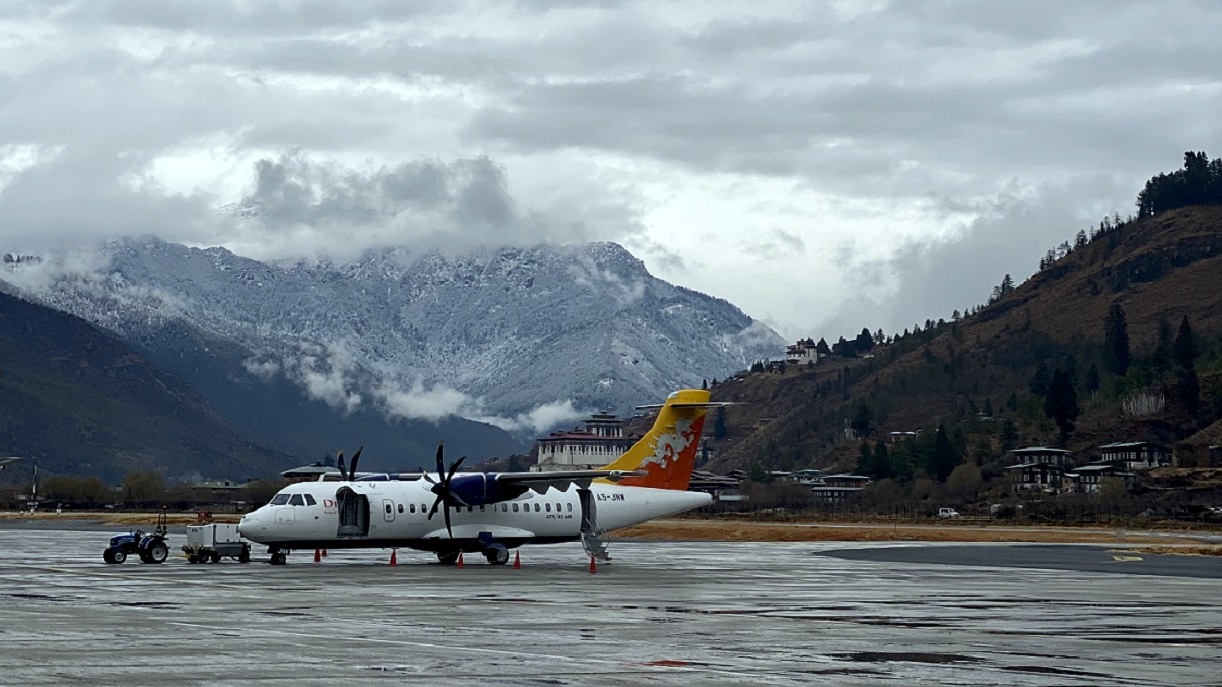
Location and Access: Situated in a deep valley at 7,300 feet above sea level, Paro International Airport is about 6 kilometers from Paro city and roughly 54 kilometers from Thimphu, the capital. Its strategic location makes it a convenient entry point for both tourists and locals traveling to and from Bhutan.
Unique Flight Experience: The airport is notorious for its challenging approach, surrounded by sharp peaks of up to 18,000 feet tall. Only a select group of pilots certified to fly in these conditions can operate here, ensuring that all flights are conducted safely during limited daylight hours and under visual flight rules.
Connectivity: As the primary air gateway, Paro International Airport offers direct flights to and from several countries including India, Thailand, Bangladesh, Nepal, and Singapore. It is serviced primarily by Bhutan's national carriers, Druk Air and Bhutan Airlines.
Facilities and Services: Despite its compact size, Paro Airport is well-equipped to handle international travelers, featuring essential services such as customs and immigration, shopping outlets, dining options, and car rental services to facilitate a comfortable travel experience.
Transportation to and from the Airport: A variety of transportation options are available at Paro International Airport, including taxis, car rentals, and buses. Most international visitors, however, benefit from pre-arranged travel packages that include airport transfers, ensuring seamless travel from the airport to their destinations within Bhutan.
Expansion and Upgrades: To accommodate growing tourist numbers and enhance operational efficiency, plans are in place to expand and modernize the airport. These upgrades aim to improve passenger comfort and processing times while maintaining the airport’s environmental and aesthetic standards.
Paro International Airport serves not just as a point of arrival and departure, but as the first impression of Bhutan for many visitors, blending modern conveniences with traditional Bhutanese hospitality.
Domestic Air Travel
Domestic air travel in Bhutan, though limited, provides an invaluable service by connecting the more remote parts of the kingdom with the major administrative and tourist centers. This mode of transportation is crucial given the country's rugged terrain and the lengthy travel times required by road. Here’s an overview of the domestic air travel scene in Bhutan:
Airports and Airstrips: Apart from Paro International Airport, Bhutan has several smaller airstrips that facilitate domestic flights. These include Bathpalathang Airport in Bumthang, Gelephu Airport in Gelephu, and Yongphulla Airport in Trashigang. These airports are strategically located to serve significant cultural and economic regions of Bhutan.
Flight Operators: Domestic flights are primarily operated by Bhutan's two airlines, Druk Air and Bhutan Airlines. These carriers use smaller aircraft suited to the short runways and challenging conditions of Bhutan’s domestic airports.
Routes and Connectivity: Domestic flights in Bhutan mainly connect Paro to Bumthang, and occasionally to Gelephu and Trashigang. This connectivity is vital for tourism, allowing visitors to access different regions of Bhutan more quickly than traveling by road.
Scenic Flights: One of the most remarkable aspects of flying domestically in Bhutan is the scenic view. Flights often offer breathtaking vistas of the Himalayas, including close views of some of Bhutan’s highest and most sacred peaks.
Time-Saving: A significant advantage of using domestic flights in Bhutan is the time saved. For instance, while the road journey from Paro to Bumthang can take up to 10 hours, a flight only takes about 30 minutes, making it a convenient option for travelers with limited time.
Accessibility and Development: Domestic flights enhance the accessibility of remote areas, which is crucial for the economic development of these regions. They enable quicker transportation of goods and services and provide a vital link for residents to access medical and educational facilities.
Sustainability Concerns: While domestic flights provide essential connectivity, there is an ongoing discussion about their environmental impact, especially given Bhutan’s commitment to maintaining its carbon-neutral status. Efforts are being made to balance these flights with Bhutan’s sustainability goals.
Domestic air travel in Bhutan, though not as extensive as in larger countries, plays a critical role in the nation's transport infrastructure. It not only supports tourism by making remote areas more accessible but also contributes to the socio-economic development of the kingdom, all while offering passengers unique aerial perspectives of the country's stunning landscapes.
Road Travel
Road travel in Bhutan offers a unique and intimate way to explore the country's breathtaking landscapes and vibrant culture. Given Bhutan's mountainous terrain, traveling by road can be both an adventure and a challenge, but it is undeniably one of the best ways to experience the beauty and diversity of the kingdom.
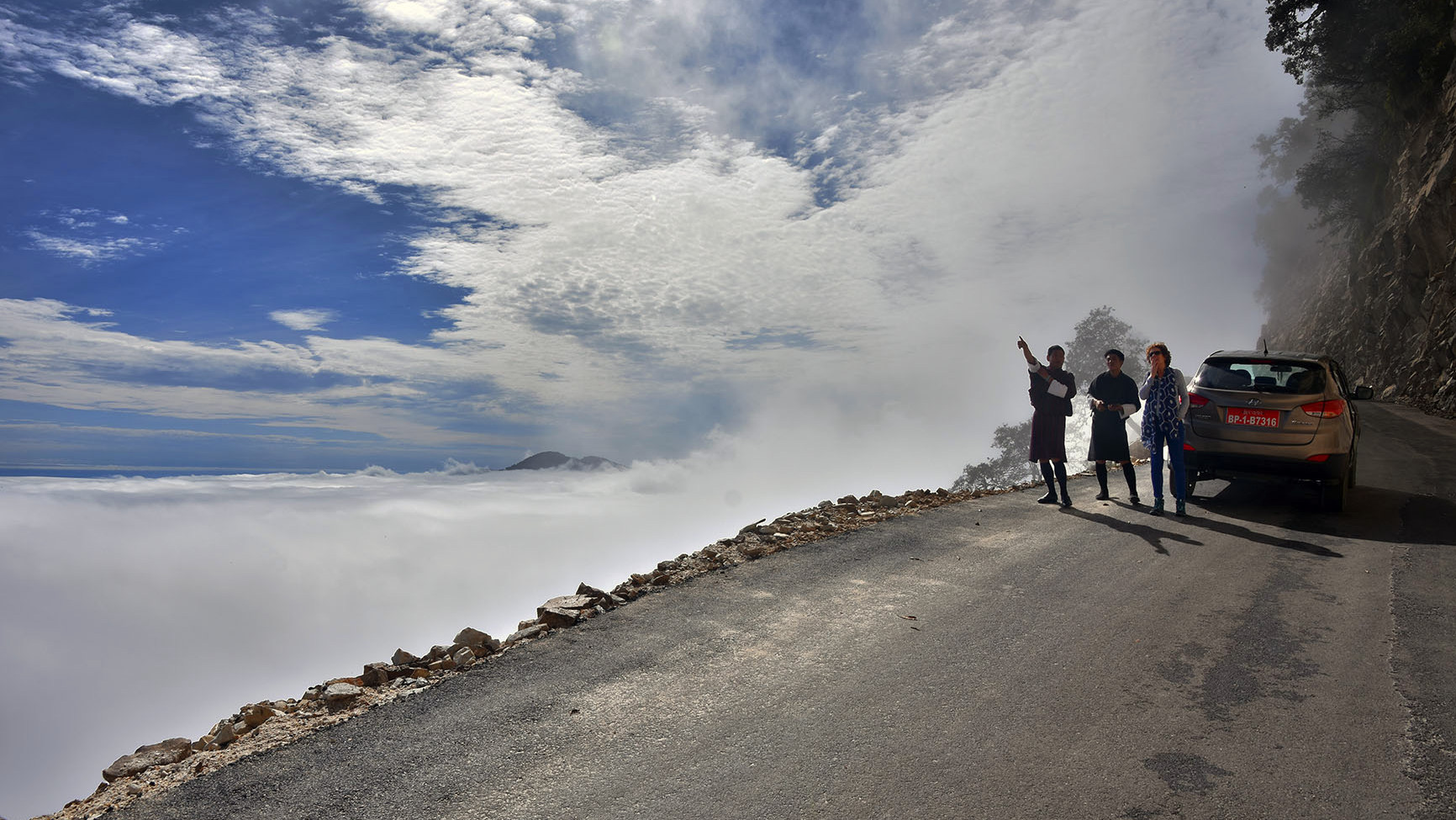
Road Network: Bhutan's road network is primarily centered around a single east-west highway, which connects major towns across the country. This highway winds through mountains, valleys, and along riverbanks, providing stunning views and access to many of Bhutan's most significant cultural sites. Secondary roads branch off to connect smaller towns and villages.
Driving Conditions: Driving in Bhutan can be challenging due to the winding, narrow roads and varying elevations. The roads are often subject to weather conditions, with frequent fog, rain, and, in winter months, snow and ice, which can lead to temporary closures. Landslides in the monsoon season also pose a significant challenge, although road crews work quickly to clear them.
Vehicle Options: For tourists, the most common way to travel is by hiring a car with a driver. This is not only because of the driving conditions but also because of the regulations that require most international visitors to travel with a licensed Bhutanese tour operator. Vehicles range from comfortable SUVs for smaller groups to larger buses for group tours.
Travel Time: Travelers should be prepared for long travel times relative to the distance covered. What looks short on a map can take hours due to the terrain and road conditions. For example, the journey from Thimphu to Punakha, though only about 77 kilometers, can take about 3 hours.
Scenic Beauty: One of the highlights of road travel in Bhutan is the incredible scenery. Routes offer panoramic views of the Himalayas, dense forests, and rich farmlands, with frequent stops available at chortens, monasteries, and lookout points.
Safety and Regulations: Bhutan places a high emphasis on road safety. Speed limits are low, and drivers are generally cautious. Tourists are required to wear seat belts, and all drivers must adhere to strict traffic laws to navigate the often treacherous roads safely.
Environmental Impact: Bhutan is environmentally conscious, and efforts are being made to improve the sustainability of road travel. This includes maintaining the roads to prevent unnecessary landscape damage and promoting the use of electric vehicles.
Road travel in Bhutan is more than just a means to get from one place to another; it's a part of the adventure that makes visiting this country so special. The journeys provide deep insights into the natural and cultural fabric of the kingdom, making every winding turn a story in itself. Whether you're passing through dense pine forests or ascending mist-covered passes, the roads of Bhutan offer a profound connection to this unique Himalayan nation.
Electric Vehicles (EVs)
Electric vehicles (EVs) are gaining traction in Bhutan as part of the nation's broader commitment to environmental sustainability and its ambitious goal to remain carbon neutral. As a kingdom deeply rooted in environmental consciousness, the adoption of EVs is seen as a significant step towards reducing carbon emissions and promoting green energy.
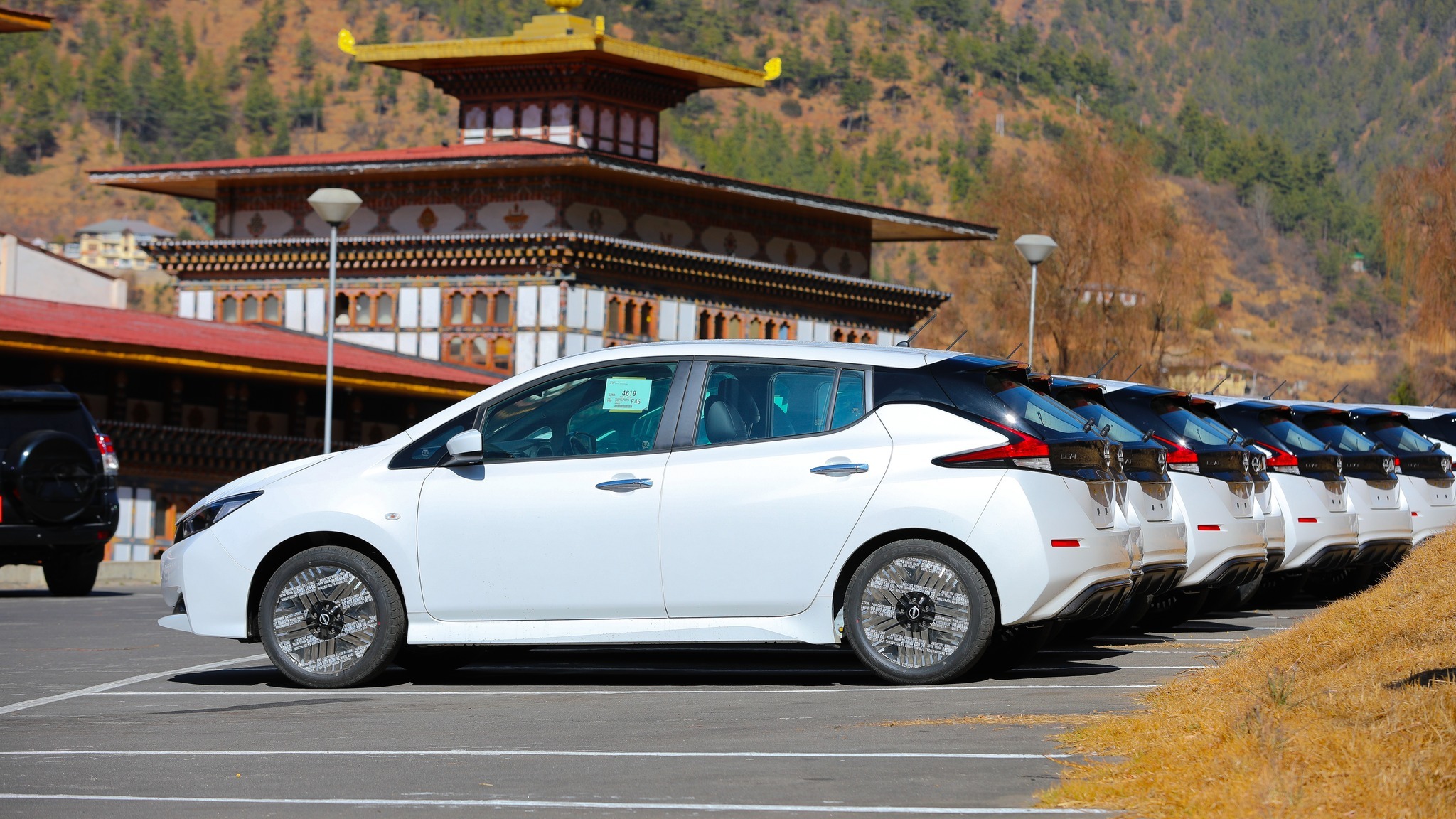
Government Initiatives: The Bhutanese government has been proactive in encouraging the use of electric vehicles. Initiatives include waiving taxes on the import of EVs and providing incentives for electric taxis. These measures are aimed at making EVs more affordable and appealing to the public and business sectors.
Infrastructure Development: To support the use of electric vehicles, Bhutan has begun to invest in necessary infrastructure. This includes the installation of EV charging stations in strategic locations such as Thimphu and Paro. These facilities are crucial for the practical use of EVs, especially given the mountainous terrain which requires efficient energy management.
Partnerships and Collaborations: Bhutan has collaborated with international partners and organizations to boost its EV capabilities. These collaborations often provide technical support and funding, aiding in the development of reliable and accessible charging infrastructure, and the introduction of modern, efficient vehicles suited to Bhutan’s topography.
Pilot Projects and Public Transportation: The government has also undertaken pilot projects to introduce electric buses and taxis in urban areas, particularly in the capital, Thimphu. This initiative not only tests the viability of EVs in Bhutan's hilly environment but also sets a precedent for reducing emissions from public transportation.
Awareness and Education: Increasing awareness about the benefits of EVs is crucial. The government and various NGOs conduct seminars and workshops to educate the public on the environmental and economic benefits of electric vehicles. These efforts aim to foster a more positive attitude towards EV adoption.
Challenges and Adaptations: Despite these efforts, the adoption of EVs in Bhutan faces challenges. The rough terrain and limited range of older electric models can be problematic. However, advancements in EV technology are gradually overcoming these hurdles, making electric cars more suited to the Bhutanese landscape.
Future Prospects: Looking forward, Bhutan aims to expand its fleet of electric vehicles, particularly in the public sector and among private users in urban areas. The government envisions a future where EVs play a major role in achieving energy sustainability and reducing reliance on imported fossil fuels.
The introduction and expansion of electric vehicles in Bhutan represent a significant environmental stride. Through government initiatives, infrastructure development, and public awareness campaigns, Bhutan is setting an example for how countries can integrate modern technology with environmental conservation policies. As technology advances and more EVs become suited to the challenges of Bhutan's geography, the vision of a greener, more sustainable transportation system becomes increasingly achievable.
Car and Motorbike Rentals
Car and motorbike rentals offer a flexible and personalized way to explore Bhutan's unique landscapes and cultural heritage. These rental services cater to the needs of travelers who prefer to navigate the winding roads and beautiful terrains of Bhutan at their own pace, providing a sense of adventure and autonomy not always possible with organized tours.
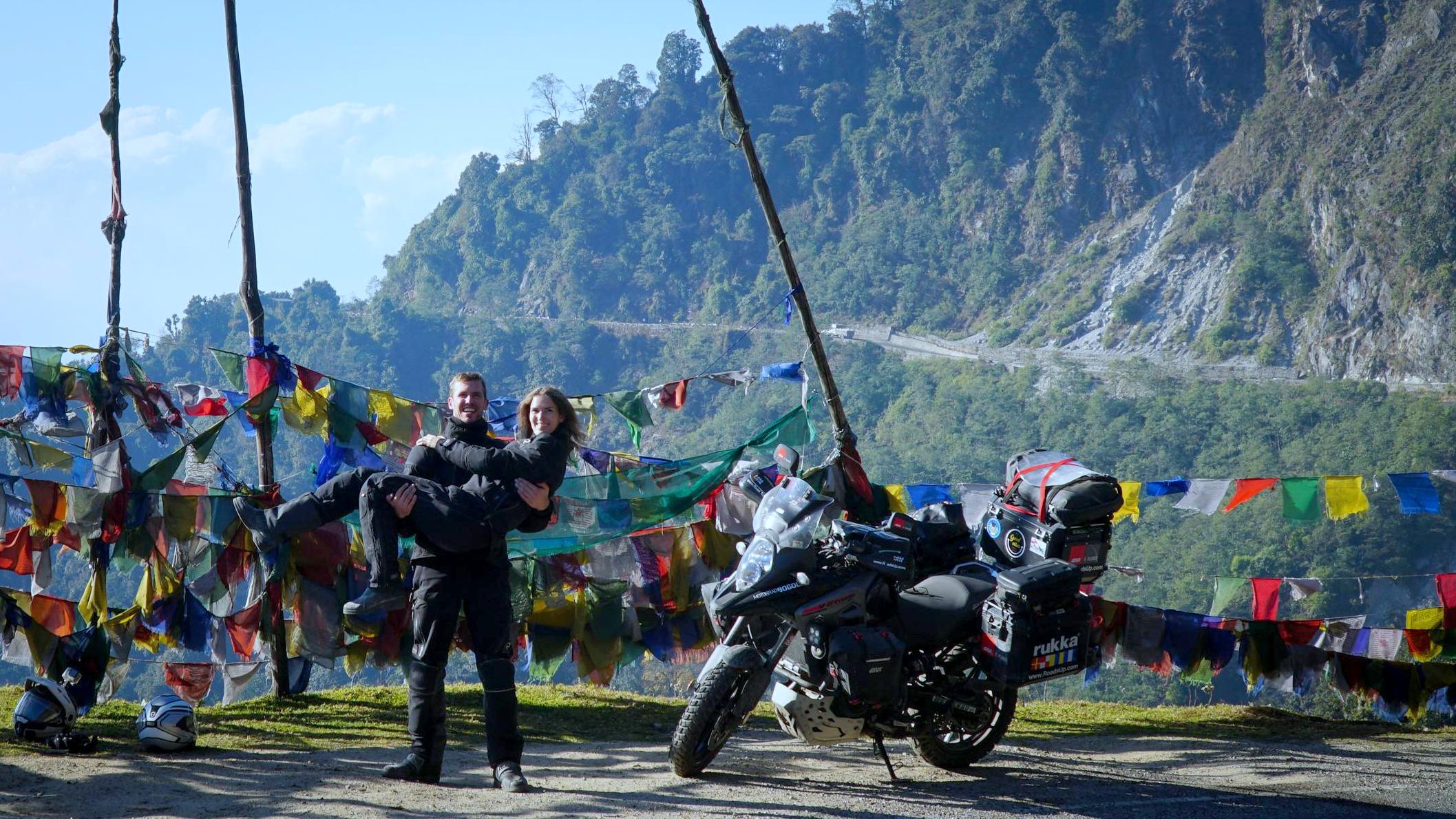
Car Rentals in Bhutan
- Availability: Car rental services in Bhutan are readily available through various tour operators and travel agencies. Most international visitors arrange their car rentals as part of their travel packages, which include a driver. This is not only due to local regulations that encourage guided tours but also because navigating Bhutan’s mountainous roads can be challenging without local driving experience.
- Types of Vehicles: The types of vehicles available for rent typically include SUVs, sedans, and minibuses. SUVs are particularly popular due to their ability to handle the often rugged Bhutanese terrain more effectively. All rental vehicles are usually well-maintained and equipped with necessary safety features to ensure a comfortable journey.
- With Driver: Given the driving conditions in Bhutan, car rentals almost always come with an experienced driver. These drivers are not only skilled at navigating the challenging roads but also serve as informal guides, enriching the travel experience with their knowledge of local culture, history, and geography.
Motorbike Rentals in Bhutan
- Freedom and Adventure: Renting a motorbike in Bhutan appeals to those seeking a more adventurous experience. It allows for greater flexibility in travel plans and the opportunity to access more remote areas that may be challenging to reach by car.
- Requirements: To rent a motorbike in Bhutan, one must typically present a valid motorcycle license from their home country. International driving permits are also recommended. Riders are expected to wear helmets at all times and adhere to local traffic laws to ensure safety.
- Popular Among Younger Tourists: Motorbike rentals are particularly popular among younger tourists and those with a keen interest in motorcycle touring. The freedom to stop at will and explore off-the-beaten-path locations makes motorbike travel an attractive option.
Advantages of Rentals
- Personalized Itineraries: Both car and motorbike rentals allow visitors to tailor their itineraries to their personal interests and schedules, making stops at attractions that might otherwise be difficult to access.
- Enhanced Experience: Traveling by private car or motorbike can enhance the travel experience, providing intimate access to the landscapes and daily life of Bhutan. It allows for spontaneous explorations and interactions that scheduled tours might miss.
- Comfort and Convenience: Especially in the case of car rentals, travelers can enjoy a comfortable journey with the convenience of personal space, storage for luggage, and the ability to manage travel times and rest stops.
Whether opting for the comfort and ease of a car rental or the thrilling autonomy of a motorbike, both options provide unique ways to explore Bhutan's extraordinary scenic beauty and cultural richness. These rental services not only add convenience but also enhance the overall travel experience in Bhutan, making them a popular choice among tourists.
Bus Services
Bus services in Bhutan provide an essential means of transportation for both locals and tourists, facilitating travel between major towns and remote areas. These services are a cost-effective and authentic way to experience the country, offering insight into Bhutanese daily life and the opportunity to interact with locals. Here’s an overview of the Bus services in Bhutan.
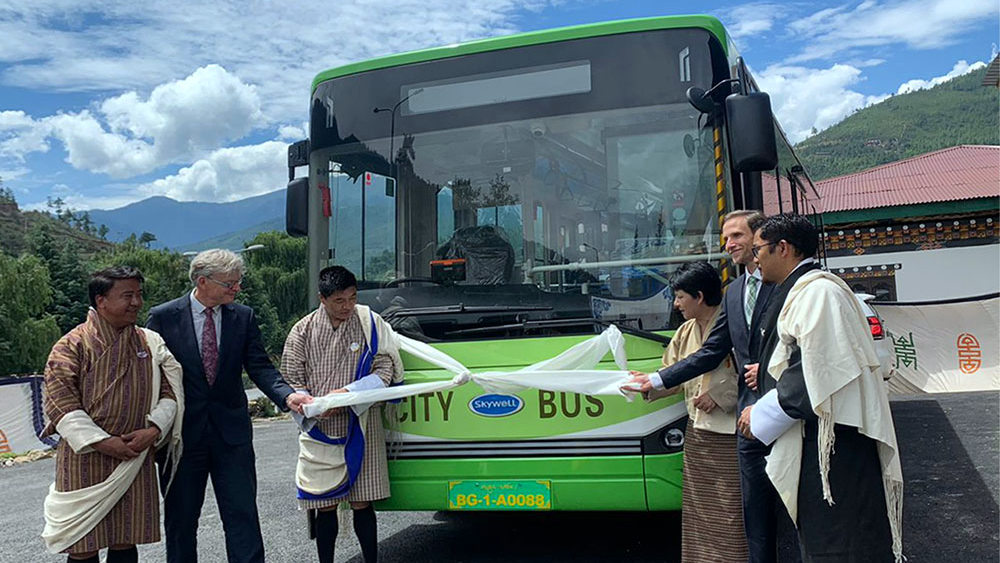
State-Run and Private Buses: Bhutan’s bus services are divided between state-run and private operators. The Royal Bhutan Government operates a fleet of buses that provide reliable and affordable transportation across the country. Private bus companies also offer services, often providing more frequent routes and additional comfort features.
Major Routes: Bus services connect all major towns and cities in Bhutan, including Thimphu, Paro, Punakha, Bumthang, and Trashigang. These routes are vital for both local commuters and tourists wishing to explore different regions of the country.
Scenic Journeys: Traveling by bus in Bhutan offers breathtaking scenic views of the Himalayan landscape. Routes often pass through lush valleys, dense forests, and alongside rushing rivers, making the journey itself a memorable part of the travel experience.
Types of Buses: Buses in Bhutan range from basic models to more comfortable options with reclining seats and air conditioning. State-run buses tend to be more economical but less luxurious, while private operators may offer more comfortable amenities.
Booking and Schedules: Bus tickets can be purchased at bus terminals, online, or through travel agents. It is advisable to book in advance, especially during peak tourist seasons. Schedules are generally adhered to, but travelers should be prepared for potential delays due to road conditions and weather.
Local Interaction: Bus travel offers a unique opportunity to interact with locals and gain a deeper understanding of Bhutanese culture. Sharing a journey with Bhutanese passengers provides insights into their way of life, traditions, and hospitality.
Safety and Comfort: While buses are a safe mode of transport, the winding mountain roads can be challenging. Buses travel at a moderate speed to ensure safety, and drivers are experienced in navigating the terrain. Passengers should be prepared for longer travel times and carry essentials like snacks and water for the journey.
Environmental Impact: Using bus services in Bhutan is an eco-friendly travel option. Buses reduce the number of individual vehicles on the road, thus contributing to Bhutan's commitment to environmental sustainability and its goal to remain carbon neutral.
Popular Bus Routes
- Thimphu to Paro: One of the most traveled routes, offering access to Paro International Airport and the famous Paro Valley.
- Thimphu to Punakha: This route takes travelers to the historic Punakha Dzong and the beautiful Punakha Valley.
- Thimphu to Bumthang: A longer journey that passes through several picturesque towns and landscapes, leading to the cultural heartland of Bhutan.
Bus travel in Bhutan is an affordable, environmentally friendly, and culturally enriching way to explore the kingdom. Whether you're traversing from one city to another or heading to a remote village, Bhutan’s bus services ensure that your journey is both safe and memorable. Opting for bus travel not only supports sustainable tourism but also provides a deeper connection to the country and its people.
Trekking
Trekking is one of the most rewarding ways to explore Bhutan, offering a deep immersion into the country's natural beauty and cultural heritage. This form of transportation not only allows travelers to access remote and pristine areas but also provides an intimate connection with the landscape and people of Bhutan. Here are the key aspects of Trekking in Bhutan:
Diverse Trekking Routes: Bhutan boasts a variety of trekking routes that cater to different skill levels and interests. From short, scenic hikes to challenging high-altitude treks, there is something for everyone. Popular routes include the Druk Path Trek, Jomolhari Trek, Snowman Trek, Gangtey Valley Trek, and Merak Sakteng Trek. Each route offers unique views, experiences, and cultural insights.
Scenic Beauty: Trekking in Bhutan provides unparalleled access to the country's stunning natural scenery. Trekkers can expect to traverse through dense forests, alpine meadows, and high mountain passes, often with spectacular views of the Himalayas. The journey itself is filled with picturesque landscapes, including lush valleys, pristine rivers, and ancient monasteries.
Cultural Experiences: Trekking routes often pass through remote villages where travelers can experience the traditional lifestyle of Bhutanese communities. This provides opportunities to interact with locals, visit ancient monasteries, and learn about Bhutanese customs and traditions. Treks like the Laya Gasa Trek and the Jomolhari Trek are known for their rich cultural encounters.
Guided Treks: Most treks in Bhutan are guided, ensuring safety and providing valuable insights into the region. Local guides are knowledgeable about the terrain, culture, and history, enhancing the trekking experience. These guided treks typically include support from porters and pack animals, making the journey more manageable.
Environmental Conservation: Bhutan places a strong emphasis on environmental conservation, and trekking in Bhutan is conducted with a deep respect for nature. Trekkers are encouraged to follow the principles of Leave No Trace, ensuring that the natural beauty of the landscape is preserved for future generations. The government regulates trekking activities to minimize environmental impact.
Physical and Mental Preparation: Trekking in Bhutan can be physically demanding, especially on high-altitude routes. It is essential for trekkers to be in good physical condition and to acclimatize properly to avoid altitude sickness. Mental preparation is also crucial, as the treks can be long and challenging, requiring perseverance and resilience.
Best Time to Trek: The best time for trekking in Bhutan is during the spring (March to May) and autumn (September to November) seasons. These periods offer stable weather, clear skies, and vibrant natural scenery. The winter months can be too cold and the monsoon season can make trails slippery and hazardous.
Trekking Permits: All trekkers in Bhutan require permits, which are usually arranged by the tour operators. These permits are part of Bhutan's tourism policy to control the number of visitors and to ensure sustainable tourism practices.
Trekking in Bhutan is more than just a means of transportation; it is an immersive journey that combines physical challenge with cultural and natural exploration. From the awe-inspiring vistas of the Himalayas to the warm hospitality of remote villages, trekking offers a profound way to experience Bhutan. With a focus on sustainability and cultural preservation, trekking in Bhutan ensures that the pristine environment and rich heritage are respected and protected. Whether you're an experienced trekker or a novice hiker, Bhutan's trekking routes promise an adventure of a lifetime.
Sustainable Practices
Bhutan is globally recognized for its commitment to environmental sustainability and its goal to remain carbon neutral. This commitment extends to its transportation sector, where various sustainable practices are being implemented to reduce carbon emissions and promote eco-friendly travel. Here’s an overview of the sustainable practices in transportation in Bhutan:
Promotion of Electric Vehicles (EVs): Bhutan has been actively promoting the use of electric vehicles in Bhutan to reduce reliance on fossil fuels. Incentives such as tax exemptions on electric vehicles and the development of EV charging stations in major towns like Thimphu and Paro support this initiative. Electric taxis and buses are increasingly seen on the roads, contributing to lower emissions and a cleaner environment.
Development of Public Transport: Enhancing Bhutan public transport options is another critical aspect of Bhutan’s sustainable practices. Improving the efficiency and reach of bus travel in Bhutan helps reduce the number of private vehicles on the road, thus decreasing overall emissions. Investments in comfortable, reliable, and affordable bus services encourage more people to opt for public transport.
Sustainable Road Infrastructure: Bhutan is focused on developing and maintaining road infrastructure in a way that minimizes environmental impact. Roads are constructed and maintained with materials and methods that reduce erosion and landslides, preserving the natural landscape. Efforts are also made to ensure that new roads do not disrupt wildlife habitats or cultural sites.
Eco-Friendly Car Rentals: Car rental in Bhutan companies are increasingly offering eco-friendly vehicle options, including hybrids and EVs. These companies promote sustainable travel by educating customers about the benefits of using greener vehicles and offering incentives for choosing them.
Promotion of Cycling and Walking: To reduce traffic congestion and pollution, Bhutan encourages cycling and walking, particularly in urban areas. Cities like Thimphu are developing cycling lanes and pedestrian-friendly zones. These efforts not only reduce emissions but also promote healthier lifestyles among residents and tourists.
Sustainable Trekking Practices: Trekking is a popular activity in Bhutan, and sustainable trekking practices are strictly enforced. Trekkers are encouraged to follow Leave No Trace principles, and tour operators ensure that waste is properly managed and natural habitats are protected. The use of local guides and porters also supports the local economy and promotes cultural preservation.
Regulatory Measures: The Bhutanese government has implemented regulatory measures to ensure sustainable transportation practices. This includes strict emission standards for vehicles, periodic vehicle inspections, and the promotion of clean energy sources. Policies are in place to limit the number of vehicles in certain areas to reduce congestion and pollution.
Education and Awareness: Raising awareness about the importance of sustainable transportation is crucial. The government, along with NGOs and private companies, conducts regular campaigns to educate the public and tourists about sustainable travel practices. These campaigns highlight the benefits of reducing carbon footprints and encourage the adoption of eco-friendly transportation options.
Bhutan's dedication to sustainable practices in transportation reflects its broader commitment to environmental conservation and cultural preservation. By promoting electric vehicles, enhancing public transport, and encouraging eco-friendly travel options, Bhutan aims to reduce its carbon emissions and protect its pristine natural environment. These efforts ensure that both residents and visitors can enjoy the beauty of Bhutan while contributing to its sustainability goals.
Transportation in Bhutan is a blend of modern innovation and traditional charm, carefully designed to navigate the country's stunning but challenging terrain. Whether arriving through Paro International Airport, exploring by bus travel, renting a car or motorbike, or trekking through remote areas, the transportation options are diverse and enriching. Bhutan’s commitment to sustainable practices, including the promotion of electric vehicles and eco-friendly travel solutions, ensures that these transportation methods not only facilitate travel but also align with the nation’s environmental goals. Traveling through Bhutan offers an unparalleled opportunity to experience its breathtaking landscapes and vibrant culture while respecting its commitment to preservation and sustainability.
FAQs of Transportation in Bhutan
Q: How can I book transportation services in Bhutan?
A: You can book transportation services in Bhutan through your tour operator or travel agency. Many travel packages include transportation options such as airport transfers, car rentals with drivers, and bus tickets.
Q: Are there ride-sharing services available in Bhutan?
A: Currently, Bhutan does not have ride-sharing services like Uber or Lyft. However, taxis and private car rentals are widely available for getting around.
Q: What is the best way to travel between cities in Bhutan?
A: The best way to travel between cities in Bhutan is by road. You can either take a bus or hire a private car with a driver. Domestic flights are also an option for longer distances.
Q: Is it safe to drive in Bhutan?
A: Driving in Bhutan can be challenging due to narrow, winding roads and varying weather conditions. It is generally recommended to hire a car with a local driver who is familiar with the terrain and traffic rules.
Q: Do I need a special permit to drive in Bhutan?
A: If you plan to drive yourself, you will need an international driving permit in addition to your home country’s driver’s license. However, most tourists opt for rental cars with drivers.
Q: What are the typical taxi fares in Bhutan?
A: Taxi fares in Bhutan are relatively affordable. Fares are usually negotiated before the trip, especially for longer distances. In urban areas, taxis operate on a meter system.
Q: Can I rent a bicycle in Bhutan?
A: Yes, renting bicycles is an option in some cities like Thimphu and Paro. It is a great way to explore the city and nearby attractions at your own pace.
Q: How do I arrange for trekking logistics?
A: Trekking logistics, including guides, porters, and permits, are typically arranged through tour operators. They will ensure you have the necessary support and permissions for your trek.
Q: Are there special transportation options for disabled travelers in Bhutan?
A: While Bhutan’s infrastructure is improving, it is still limited in terms of accessibility. It is advisable to discuss your specific needs with your tour operator, who can arrange appropriate transportation and accommodations.
Q: What should I know about traveling during the monsoon season?
A: Traveling during the monsoon season (June to September) can be challenging due to potential road closures from landslides. It is important to stay informed about road conditions and have flexible travel plans during this time.



